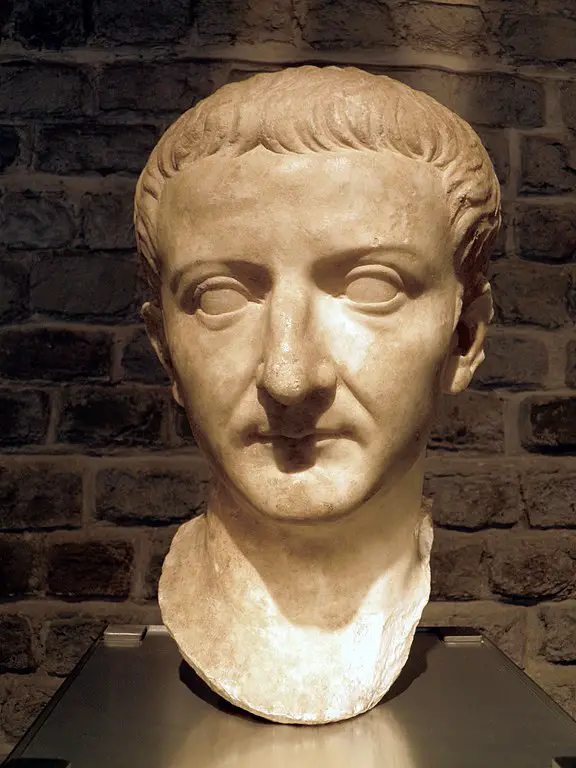Tiberius
Tiberius Claudius Nero or simply Tiberius was the second Roman Emperor. He ruled Rome after the death of his stepfather Augustus from 14 C.E. until 37 C.E.
He was part of the Julio-Claudian Dynasty in ancient Rome. Tiberius spent much of his time as Roman Emperor in a self-imposed exile from Rome. While he was in exile, the city of Rome and the Roman Empire was ruled by Sejanus and his mother Livia, Augustus’ third wife.

Early years
Tiberius was born in Rome during 42 B.C.E. to Tiberius Claudius Nero and Livia Drusilla. The family claimed Claudian descent and therefore held much wealth. His mother, Livia, would divorce Nero when Tiberius was four years old. Livia would then marry Octavian, who would later become Augustus and the first Roman Emperor.
Not much is known of Tiberius’ childhood. We assume he was well educated because of his family’s wealth. At the age of nine years, old Tiberius read the eulogy at his father, Nero’s funeral. After the defeat of Marc Antony and Cleopatra in 29 B.C.E., he rode in the triumphal chariot along with his stepfather Octavian.
He entered politics as a quaestor in 24 B.C.E. at the encouragement of his stepfather Augustus. In 20 B.C.E., Tiberius was sent to Armenia with Augustus’ greatest general named Marcus Vipsanius Agrippa. At this time, Tiberius married the general’s daughter named Vipsania Agrippa.
Tiberius was then appointed a praetor and led his troops to the Alps. Here his troops conquered Raetia. During his campaign, Tiberius found the sources of the Danube River. In 13 B.C.E., he returned to Rome, where he was appointed consul. Upon the death of Agrippa in 12 B.C.E. Tiberius and his brother Drusus were placed in the line of succession to Augustus.
All was not right in Tiberius’s household after Agrippa’s death. In 11 B.C.E., his father Augustus insisted he divorce his wife Vaspania and marry Julia the Elder, who was the daughter of Augustus. The second marriage proved happy in the beginning but eventually would turn bad.
Upon Tiberius’ brother’s death in 9 B.C.E., it seemed clear to everyone that Tiberius would be the next emperor. Tiberius was then sent to squash rebellions near the Danube River, where he was successful. In 7 B.C.E., Tiberius returned to Rome victoriously and appointed consul once again.
Retirement in Rhodes
In 6 B.C.E., Tiberius made a surprise announcement and retired from politics. He then moved to Rhodes. Tiberius tried to return to Rome several times but was not allowed by Augusts to return. But in 4 C.E., Augustus allowed Tiberius to return to Rome after the death of his two grandsons.
At this point, Tiberius was adopted as a full son of Augustus and was named heir to the throne. Around 12 C.E., Tiberius was given the same authority as Augustus. Upon the death of Augustus in 14 C.E., Tiberius assumed the role of the Roman Emperor.
Emperor of Rome and Sejanus
One of the first things Tiberius did as emperor was to ban all non-Roman cultures, including astrologers, and tightened the strings on the Roman Empire’s budget. He then sent troops to Germania to put down another rebellion against the empire.
Tiberius named a lifelong government official Sejanus to help rule Rome. Tiberius was happy with Sejanus and even erected numerous statues of the man around Rome. In 26 C.E., Tiberius moved to Capri and left Sejanus in charge.

Unfortunately, Sejanus began a series of purges against senators in Rome. This did not sit well with Tiberius. At this point, Sejanus and Tiberius were joint consuls. Tiberius removed himself as consul, which forced Sejanus to do the same. In 31 C.E., Sejanus was put on trial for treason and executed.
Later years
Towards the end of his reign of Rome, Tiberius left all major decisions to officials in Rome. He did, however, have a problem with succession. But in the end, another member of the Julio-Claudian Dynasty, Caligula, was named the new Roman Emperor upon the death of Tiberius.
Important facts about Tiberius
- Tiberius Claudius Nero, simply known as Tiberius, was born in 42 B.C.E. At a young age, his mother, Livia, divorced his father and married Octavian.
- Octavian would later become the first emperor of Rome and be given the title of Augustus.
- Tiberius rode with his stepfather in the triumphal chariot after Augustus defeated Marc Antony and Cleopatra of Egypt.
- He was appointed as a quaestor of Rome in 24 B.C.E.
- Tiberius as a good general and led many military campaigns to victory as a young man. He discovered the origins of the Danube River while conquering Raetia.
- Augustus forced Tiberius to divorce his first wife and marry his stepsister named Julia the Elder.
- Tiberius was the second Roman Emperor of the Julio Claudian Dynasty.
- When he became Roman Emperor, he put a lifelong Roman official in charge of the city of Rome named Sejanus. Later he would execute Sejanus for treason.
- Tiberius was succeeded as Roman Emperor by Caligula, his adopted grandson.
Questions
Who was Tiberius’ stepfather?
Augustus
What was the first political position held by Tiberius?
Quaestor
What family dynasty was Tiberius from?
Julio Claudian Dynasty
Who did Tiberius leave in charge of ruling the city of Rome?
Sejanus
When Tiberius died, who succeeded him as Roman Emperor?
Caligula



